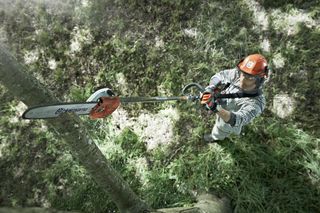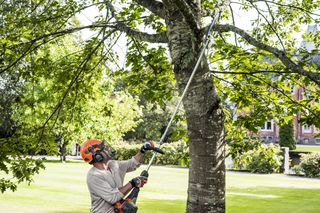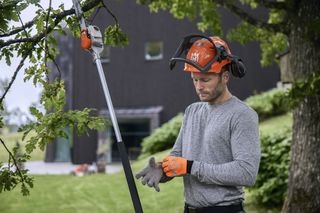
How To Safely Trim Branches Without Needing A Ladder
When the time comes for an overgrown or damaged tree to be trimmed, you have three options to choose from. (1) Dig out the ladder and chainsaw. (2) Call in the professionals. (3) Get yourself a pole saw.
From unstable ladders and high-powered equipment, accidental cuts, falls and being hit by branches from a height are among the biggest threats to be aware of. Without the correct PPE, arborist safety gear and training, ladders and chainsaws are like oil and water - they don't really mix.
We spoke with professional arborist and tree care specialist Sam Hardingham from Everyday Arbor and asked him to share some of his top tips for using a pole saw, so you get to work while keeping your feet firmly on the ground.
Benefits of electric pole saws
Sam mentioned that pole saws come with plenty of handy benefits for home owners looking to maintain their trees and shrubs. Instead of getting up on a ladder and having to use a handsaw in an awkward or dangerous position, a pole saw lets you trim tree branches around fences, rooflines or gutters - making it an essential tool for property maintenance. Plus battery-powered pole saws come with plenty of other benefits, such as;
- Light-weight and ergonomic designs.
- Low vibration, low noise, no fumes.
- Durable telescopic shaft.
- Cord and cable-free.
- Optimised balance for working at height.

Improved safety
The most apparent benefit to safety is not having to climb a ladder or the tree to prune high up branches. As Sam mentioned:
"A pole saw is a great tool for pruning trees for asset clearance, clearing overhanging branches from roofs, fences, and driveways... and even clearing storm damage and keeping trees healthy and in check."
By keeping your feet firmly on the ground and not on a shaky ladder, you have better control and manoeuvrability when felling branches. Should you accidentally slip or trip, the business end of a pole saw should be several metres from you, whereas this isn't the case for a chainsaw. While PPE is always recommended, you won't need to invest in arborist tools, harnesses, ladders, pulleys, etc.
Pole saw safety tips
- Before cutting, make sure the area is free from nails, metal and wires.
- Scan the area around the tree and move anything that could be damaged.
- Wear PPE, including a safety helmet, goggles and hearing protection.
- Hold your pole saw with one hand on the front handle, and one on the rear.
- Stand on a firm, fixed and level surface to minimise the risk of slipping.
- Only operate a pole saw from the ground, not from within a tree.

Work to your own schedule
While tree care is typically predictable, there are certain times and situations when pruning and cutting tasks need immediate attention. Sam notes:
"As a professional, I take my pole saw everywhere. I have it around for every job because you never know when you are going to need it."
Whether it's damage due to a recent storm, diseased limbs posing a danger or branches about to encroach on power lines, gutters or cables, being able to get to work straight away without waiting is a definite plus. Not only are you able to work to your own schedule, but you'll also save yourself money on needing to call the professionals out.
Of course, there will always be situations where professionals will need to step in, but for smaller tasks and general pruning, trimming and shaping - an electric pole saw can be the perfect time and money-saving tool for you.
Sam's expert tips for electric pole saws
To help you make the most of every cut, Sam has a few expert tips to follow when using an electric pole saw such as the Husqvarna 530iPT5 in the garden.
Know the species of tree you're cutting
Sam mentioned that tree pruning is like a haircut. "It's not about the amount that gets cut off, but more about what gets left on." On some species, the bark tears more easily and can cause damage to the part of the tree you're aiming to keep. Knowing the species and the properties of the wood of the tree you'll be cutting can help you get a cleaner cut exactly where you want.
The easiest cutting sequence
Another cutting tip Sam recommends is to shorten branches in sections rather than all at once, which helps minimise the risk of them tearing and leaving dirty, fungus-prone cuts. This also prevents large, heavy branches from crashing to the ground damaging fences, walls or windows.
Optimise your chain before starting
A sharp chain requires less force to make the cut, reducing fatigue and increasing the accuracy of cuts. By keeping your pole saw chain sharp and the tension properly adjusted, you'll find cuts are smoother, cleaner and easier to make. If your pole saw is self-priming, check the chain is lubricated enough. If not, apply the recommended mineral oil before getting started.
Find the best cutting position
Finding the best position to cut from ensures that the operator is in a safe position to complete the cut. When pruning and making the final cut at the branch collar, finding the most appropriate place to cut from will mean the tree will have the best chance of responding.
“At the end of the day the most important thing for the tree is the cut you leave.”

Getting started with a pole saw:
- Clear the area beneath and around the branches you'll be removing, making sure any trip hazards are out of the way. It's also a good idea to cordon off the area to keep people, kids and pets out of the way just in case you need to move quickly.
- Know the types of cuts and where you'll need to make them before getting started. Shorten the branch in sections to reduce its weight before making the final cut.
- Find your footings on a level and fixed surface. Most people find holding the saw at chest height with feet wide apart to be most comfortable. As you'll be cutting from one side and not directly from beneath, a harness can help reduce any strain during use.
- Make your first cut perpendicular to the branch, using controlled and firm motions to create grooves. These grooves will help you get a better bite into the branch, preventing angles or slopes from causing the saw to slip. Remove the end of the branch first, working inwards in small sections.
- Make your last cut by increasing stroke speed. Remember that pole saws cut on the pull stroke, so be sure to watch the branch as it starts to move so you can get out of the way should it break away early.
Reach new heights with a Husqvarna pole saw
The Husqvarna range of battery and petrol pole saws make it possible for home owners to take care of their regular pruning, trimming and cutting tasks without ever needing to step foot on a ladder.
Enjoy maximum cutting power and precision, ergonomic designs, savE™ mode, IPX4 weatherproof classification, a rear-impact guard and many other beneficial features that deliver a professional finish, time after time.
Find your pole saw match today, or visit your local Husqvarna dealer for more.